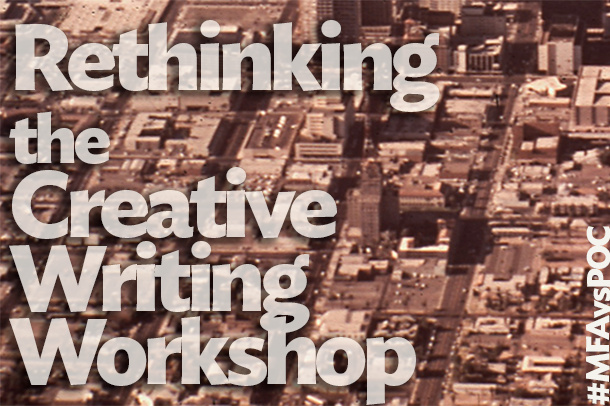In the typical creative writing workshop, a group of the writer’s peers discuss her work while she stays silent. “One of the most useful things a workshop can do for the writer is to reflect the intention of the work back to her,” author Peter Turchi writes. The “gag rule” operates on the premise that the writer is in the dark with regard to her own subconscious. Many writers know the feeling. The danger is that the workshop ends up critiquing imagined intentions, projected intentions, rather than the author’s actual intentions. It is a problem, I would argue, more common for marginalized writers, and a problem that stems from the way the workshop talks about “the reader.”
I graduated with my MFA in 2009 and have taught writing workshops since 2011. In my MFA program, I took nine workshops of various quality. One professor told me that if I wanted to experiment, I was in the wrong program. My favorite professor taught me most of what I know about writing still. What my peers and I admired about this professor was her ability to see our stories as we saw them. I wrote only one story she didn’t “get.” It was the one that came closest to the material of my adoption.
I have wondered both how she was able to see our intentions so well and why she wasn’t able to with that one story. After my first two years of teaching fiction workshops, I spent part of a writing conference asking how other authors run their classes. The answer that changed my teaching came from author Nami Mun, who said she leads each workshop differently since each story is different. This made sense to me in the same way that trying to see a story as its author intended it made sense to me. I started (selectively) dropping the gag rule or skipping discussion to map structure on the wall or reframing a short story as a potential novel. My students agreed that this approach was helpful.
But I was teaching largely homogenous classes—white, female, middle-class students. Every once in a while, we workshopped a story that required a discussion about race, and I would find myself both the only person of color in the room and the instructor. This is a difficult situation to navigate, and I often chose to talk about “craft” instead of prejudice.
Now I am a student again, a Ph.D. candidate in Creative Writing & Literature at the University of Houston. My program is more diverse than most workshops I lead. I write about race far more than when I was in my MFA. But discussions of race in the workshop still mostly talk around, ignore, or exoticize race. Why?
Recently, a narrative theory course in which I was a student considered classifications such as the “implied” reader versus the “real” reader—in other words, the author’s intended reader and the actual human reading. The professor asked whether readers come up in creative writing workshops, and we insisted that we often talk about the reader. Then the question became: When we talk about readers, do we mean a specific reader or a general reader?
In my experience, the typical workshop talks about “the reader” as if he is someone with a standard set of expectations for arc, plot, characterization, etc. When we say “the reader,” we make little or no distinction between a male reader or a female reader, a white reader or a black reader, a cis straight reader or an LGBTQ reader. But the of course the audience is different for different writers. Perhaps the workshop acknowledges this fact indirectly—by imagining the writer’s intentions or by citing other authors with similar approaches (and hence, audiences?). Perhaps the best professors judge both the author’s intentions and her intended readers. But for the most part, difference in readerships is often overlooked or othered.
A common complaint about the proliferation of MFA programs is that they breed generic writing. Writers in my MFA and PhD programs have been interested in the most “experimental” and the most “traditional” fiction. On the other hand, they usually write for the same audience: peers in the program and the mysterious literary “reader.” The danger of MFA programs isn’t a singular style; it is a singular perspective. Creative writing programs are notoriously white, and the way “the reader” is discussed makes the reader white (and cis and straight and, often, male).
What if the workshop considered who in particular the “reader” is for each writer? Treated each story differently in terms of how it is written and who it is written for? It is difficult to “reflect the intention of the work back to [the author]” if the imagined reader does not reflect the intended reader. It is wrong to assume that we all write for the same audience. The workshop should create an environment where the writer is read and critiqued on terms that make individual sense. When the group critiques a piece of writing from the position of a single normative reader, when it claims that art speaks to “universal” truths as if truth is not cultural, it demands that difference, individual difference, be erased or exaggerated. What the marginalized writer is left with then is work that is no longer hers. It is work, at best, that belongs to the workshop and, at worst, to no one.
This essay is part of our Fall #FridayReads series: Rethinking The Creative Writing Workshop. Click to learn more and see more great content.

